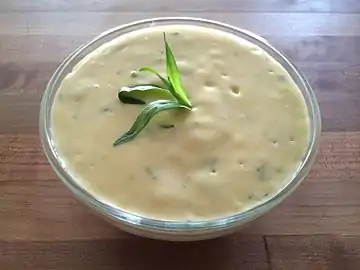Béarnaise sauce
Béarnaise sauce (/bərˈneɪz/; French: [be.aʁ.nɛz]) is a sauce made of clarified butter emulsified in egg yolks and white wine vinegar and flavored with herbs. It is widely regarded as the "child" of the Hollandaise sauce. [1] The difference is only in the flavoring: Béarnaise uses shallot, chervil, peppercorns, and tarragon in a reduction of vinegar and wine, while Hollandaise is made of a reduction of lemon juice or white wine vinegar, with white peppercorns and a pinch of cayenne instead of the above seasonings.
 | |
| Type | Sauce |
|---|---|
| Place of origin | France |
| Main ingredients | Egg yolk, clarified butter, white wine vinegar |
The sauce's name is related to the province of Béarn, France. It is light yellow and opaque, smooth and creamy, and a traditional sauce for steak.[2][3]
History
The sauce was accidentally invented by the chef Jean-Louis Françoise-Collinet, the accidental inventor of puffed potatoes (pommes de terre soufflées),[4] and served at the 1836 opening of Le Pavillon Henri IV, a restaurant at Saint-Germain-en-Laye. This assumption is supported by the fact that the restaurant was in the former residence of Henry IV of France, a gourmet himself, who was from Béarn,[4][5] a former province now in the department of Pyrénées-Atlantiques.
Preparation
A Béarnaise sauce is simply clarified butter, an egg yolk, a shallot, a little tarragon vinegar. It takes years of practice for the result to be perfect. – Fernand Point [6]
As with Hollandaise sauce, there are several methods for preparing of Béarnaise sauce. The most common uses a bain-marie (whisking to a temperature of 150F (65.6C)),[7] where a reduction of vinegar is used to acidulate the yolks. Escoffier[2] calls for a reduction of wine, vinegar, shallots, fresh chervil, fresh tarragon and crushed peppercorns (later strained out), with fresh tarragon and chervil to finish instead of lemon juice. Others are similar.[8]
Alternatively, the flavorings may be added to a finished Hollandaise (without lemon juice). Joy of Cooking[9] describes a blender preparation with the same ingredients.
Derivatives
- Sauce Choron or sauce béarnaise tomatée is a variation of béarnaise without tarragon or chervil, but with added tomato purée.[9][10] It is named after Alexandre Étienne Choron.
- Sauce Foyot (also known as Valois) is béarnaise with meat glaze (glace de viande) added.[9][11]
- Sauce Paloise is a version of béarnaise with mint substituted for tarragon.[12]
See also
- List of sauces
- Steak sauce
References
- The family is sometimes referred to as "mayonnaise sauces" as they are, like mayonnaise, based on the emulsion of an oil in egg water.
- Escoffier: 89
- Julia Child
- "La sauce béarnaise". 16 May 2015.
- "What is Bearnaise sauce? | Cookthink". Archived from the original on 2009-06-02. Retrieved 2010-03-08.
- Restaurateur Fernand Point (1897–1955) in Ma Gastronomie.
- "How to Make Hollandaise | A French Mother Sauce | Stella Culinary".
- Cookwise, pp.304-5
- Joy of Cooking p.359
- Escoffier: 90
- Escoffier: 91
- Escoffier: 141
- Sources
- Child, Julia; Louisette Bertholle; Simone Beck (1961). Mastering the Art of French Cooking. New York: Knopf.
- Corriher, Shirley (1997). "Ch. 4: sauce sense". Cookwise, the Hows and Whys of Successful Cooking (1st ed.). New York: William Morrow & Company, Inc. ISBN 0688102298.
- David, Elizabeth (1960). French Provincial Cooking. Penguin. ISBN 978-0-14-118153-0.
- Escoffier, Auguste (1982) [Trans. fm 4th French (Flammarion) ed. 1921]. "Ch. 1: Sauces". La Guide Culinaire [The Complete Guide to the Art of Modern Cookery] (in French). English translation by H.L. Cracknell and R.J. Kaufmann (First American ed.). New York: Mayflower Books. ISBN 0-8317-5478-8.
- Rombauer, Irma S.; Rombauer Becker, Marion (1975). Joy of Cooking. New York: The Bobbs-Merrill Company, Inc. (MacMillan). ISBN 0-02-604570-2.
External links
- Béarnaise sauce from the British Good Food TV channel